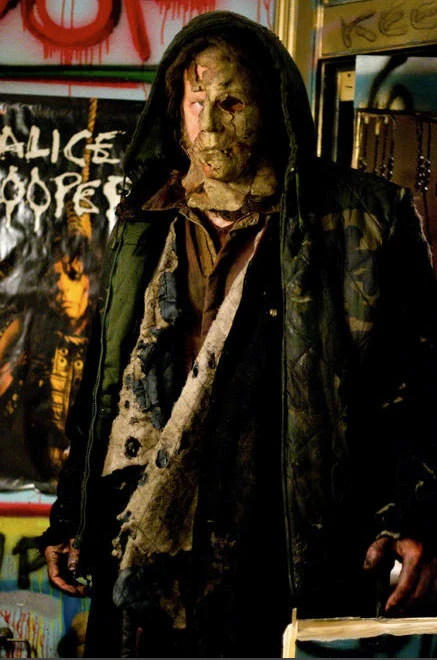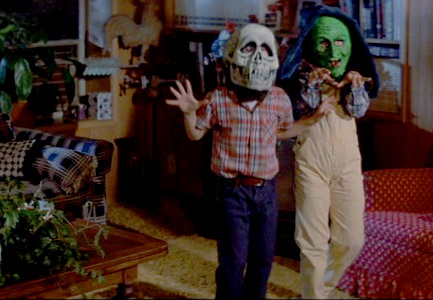With a recent comprehensive Blu-ray set being released for the Halloween franchise, I’ve been revisiting some installments that I’m less familiar with. Rather than remind me of the strengths of the series, these movies merely remind me that Michael Myers, the character, is the worst thing about the whole franchise. John Carpenter‘s Halloween is generally regarded as one of the best slashers of all time, and for good reason. Halloween III: Season of the Witch is the black sheep of the whole franchise, as it’s the only film that doesn’t feature Myers, but it also stands out as being the best sequel in the series that creates its own mythology. Other than these two installments, the rest of the films are a mundane series of deadly hide and seek scrimmages that are strung together by a razor-thin plot that only exists to justify how and why Michael Myers keeps showing up. Unfortunately, every excuse for Michael Myers to appear just reinforces why he’s the worst character of the whole franchise. To give a little more context, let’s run down the films individually.
In Halloween, a young boy murders his sister on Halloween night. He gets locked up in a mental institution for 15 years, until he escapes the night before Halloween. Based on a trail of bodies, his doctor (Donald Pleasence) surmises he’s heading back to his hometown of Haddonfield, IL. On October 31 back in Haddonfield, Laurie Strode (Jamie Lee Curtis) has the feeling that she’s being watched. The horror of this film isn’t about the name of the person behind the mask or why he stalks anyone in particular, but rather it explores the fears of the unknown assailant or more broadly, the “other.” Laurie can neither confirm nor deny her suspicions of being watched all day, but when she does, it’s too late and her pursuer springs into action. The importance of the story taking place on Halloween comes from the customs of the holiday, where it’s okay to intimidate others with scary costumes, if only for that one night. The story certainly could have been as effective if it took place on any other night, but Laurie’s stalker, referred to as “The Shape,” blends in with all the other creeps trying to intimidate people and also gives Laurie doubts about her suspicions.
Although the tide has turned among horror fans in the decades since its release, Halloween III: Season of the Witch originally received poor critical and box office reception. The previous two films focused on Michael Myers, who audiences learned stalked Laurie Strode because she was his sister. HIII:SotW went a completely different direction by telling a tale set in a world where Michael Myers was a character in a movie, but a story still reliant on Halloween traditions. This film focused on the evil Silver Shamrock company that created masks to possess the wearer, causing violent outbursts and bugs to explode their heads. Although John Carpenter handed over writing and directing duties to collaborator Tommy Lee Wallace, the story followed Carpenter’s original intentions for the Halloween franchise, which was to tell different Halloween-centric stories.
Halloween and Halloween III: Season of the Witch are the only noteworthy, unique, or interesting installments in a relatively boring series of films. Halloween II was written by Carpenter, under studio order, and takes place immediately following the first film. In retrospect, knowing that this movie was made mostly to open the door for the events of Halloween III means I won’t judge it too severely, other than it establishing the unfortunate concept of Michael tracking down his family. Due to the poor reception of Halloween III, the studios reverted back to the formula of Michael Myers hunting down his family, now featuring his niece in the aptly titled Halloween 4: The Return of Michael Myers. Maybe the “interesting” twist with this installment is that he pursued a child? The whole movie plays out like a run-of-the-mill slasher, but this one just happens to feature the familiar Michael Myers mask. In Halloween 5: The Revenge of Michael Myers, Michael finishes the job he started in the previous film by killing his niece, so to fill the narrative void of no more family members, the filmmakers introduce the concept of the “Cult of Thorn,” who are supposedly the ones responsible for Michael’s evil behavior all along. Sadly, the cult is only barely touched upon but paves the way for its sequel.
Halloween: The Curse of Michael Myers focused more on the mysterious cult that performed rituals on Michael when he was a baby to shape his supernatural behavior. Test audiences didn’t enjoy the direction the franchise went with the cult mythology so huge chunks of the film were re-shot to make the film feel like your average slasher, which is what the result felt like. I guess that make it in line with the rest of the franchise though? The recently released producer’s cut of the film focused more on the cult, and even though it’s not a great movie, there are some very bold decisions made, especially with the ending. The studio went even deeper back down the well for the next movie, Halloween H20: 20 Years Later by bringing back Jamie Lee Curtis. The film focused on Michael coming after the still alive Laurie because her son has just turned 17 and that’s how old Laurie was when Michael originally sought her out. Thanks to films like Scream and I Know What You Did Last Summer, the teen slasher was at its peak, which this film hoped to capitalize on. It also brought Jamie Lee Curtis back to the franchise, but that couldn’t save it from being another generic slasher. The next installment, Halloween: Resurrection, brought back Laurie once again, only to kill her in the opening scene. The rest of the film centers around a reality gameshow where contestants spend the night in Myers’ childhood home, while also abandoning almost all of the character’s mythology. With no more relatives left, Michael kills the contestants of the show because…they’re in his house?
Rob Zombie’s version of Halloween spent almost the entire first half building young Michael Myers as a sympathetic character, which is probably the last thing I wanted to see. There are some cool stylistic things going on, but overall it portrays the character completely differently from how the original film shows the character, so I couldn’t have been less interested. Zombie’s Halloween II continued in the universe he built, but feels more similar in plot to some of the sequels to the original film. There are more experimental sequences involving hallucinations, which strengthen the connection between Michael and Laurie Strode (Scout Taylor-Compton), and this sequel also portrays Dr. Loomis (Malcolm McDowell) as a money-grubbing child psychologist as opposed to Donald Pleasance‘s portrayal, as a doctor desperate to help his patient. I initially loathed this film, but after a recent viewing of it, I don’t think it does more harm to the franchise than any other of the installments and features some of the best cinematography out of any of the films.
What’s consistent in the A Nightmare on Elm Street franchise is that Freddy Krueger (Robert Englund) will invade his victims’ dreams, resulting in their real life deaths. With Friday the 13th films, Jason Voorhees will raise from the dead in a hockey mask and kill enough sex-having, drug-doing teens to satiate his thirst for revenge. In the Hellraiser films, a mysterious box is found and when opened, alters whoever opens the box’s reality, usually to Hellish results. The Child’s Play franchise has always focused on the spirit of Charles Lee Ray (Brad Douriff) inhabiting a doll and trying to find his way back into a human body. Basically EVERY other horror franchise does a better job of sticking to the successful components of the first installment, which normally means that the main antagonist is featured every single time.
A few years ago I reviewed every installment that had been released of these four major franchises and my results, as you can read here, were relatively inconclusive. When someone says they love Friday the 13th or A Nightmare on Elm Street, I might not agree with them but I can understand that they’re a fan of what’s regularly featured in that film and the consistency of them. I love both Halloween and Halloween III but can’t fathom how someone could be a fan of Michael Myers and how poorly he’s represented in the franchise. His backstory is repeatedly altered or ignored and he has little screen presence other than “guy in familiar mask.” Despite being the face of the franchise, I can’t think of a worse thing to have happened to the Halloween franchise than the character of Michael Myers.







Great post. I haven’t seen all the Halloween films, not by a long shot, and I’m not sure I’m actually that keen!
Just found your site and really digging it… Great article…
Your gay
Thanks!